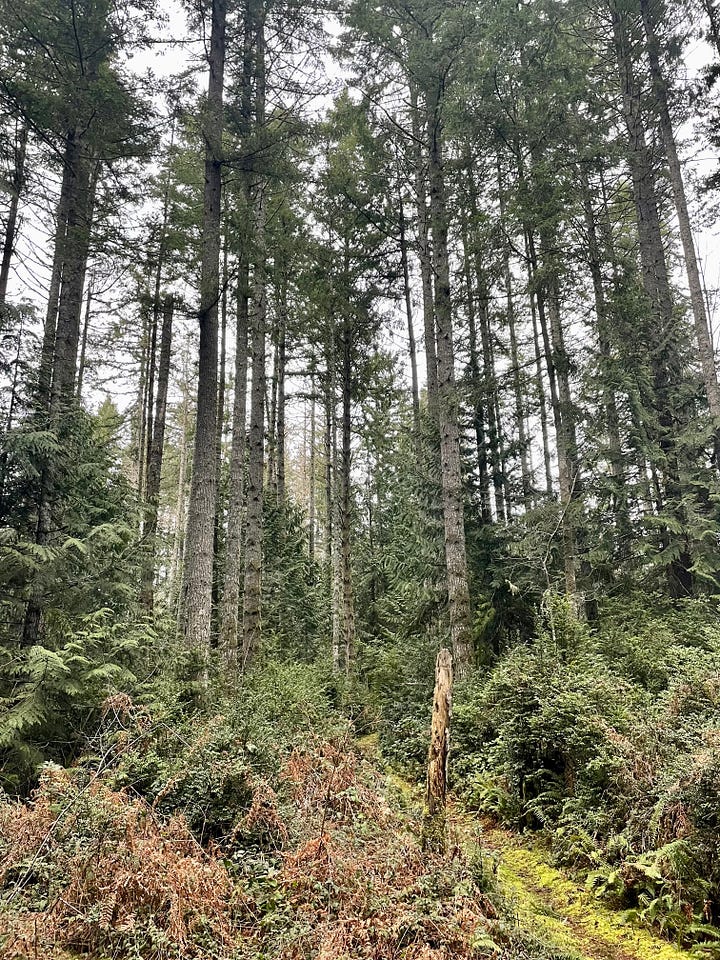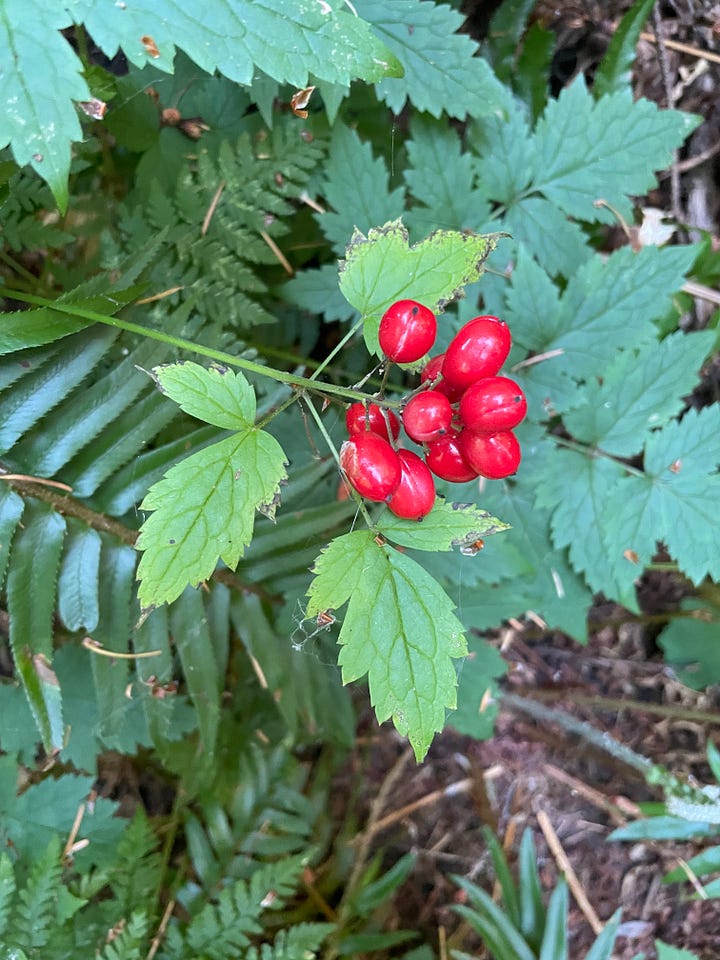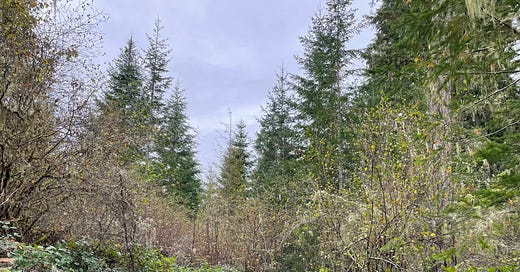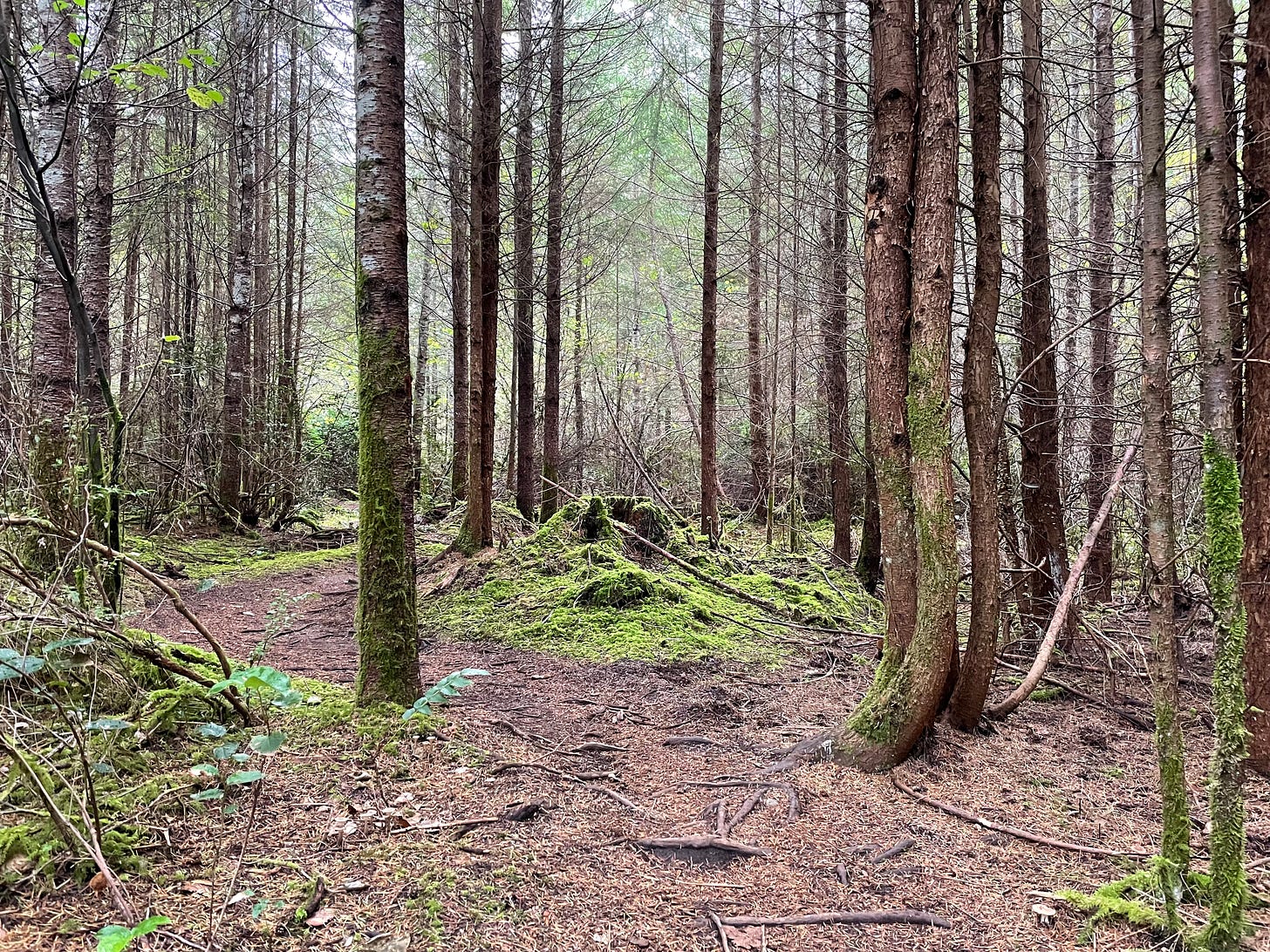Here I come, you meaty mushrooms and blood-red berries. You passing bands of kinglets.
The sky may be gray and the tree limbs skeletal, here in late fall, but the forest understory is a riot of color and, honestly, flesh. I cross a disco carpet of fallen willow leaves as I climb into 360 Trails, ready to explore.
Pretty soon I find myself ducking into a hollow carpeted with moss. It glows with health. A chickaree cries and the cry is dampened. The moss is that thick. Scattered across it like hailstones are hundreds of tiny white mushrooms. They’ll probably last about as long.
In forestry, nearly all attention is given to the trees. How we understand a forest—its growth stages, its health, management priorities, prospects of long-term sustainability and climate resilience—revolves quite naturally around the forest’s dominant members.
Trees hold sway over conservation thinking too: think of the initiatives to plant millions of trees, to value the carbon captured in trees. And literature: in Annie Proulx’s Barkskins and the Pulitzer-winning Richard Powers epic The Overstory, it’s trees, their planting and cutting, their shade and wood and deep connective powers that give them a top-level influence on the plotline of civilization.
Wood is a big part of my own cultural DNA. But today I forget to look up. 360 Trails is like a classroom on the reemergence of forest understory. When the ghostly trill of a varied thrush comes through the hollow, and I can just about see the white mushrooms quiver on their minuscule stalks, I get a brief vision of something like glass capillaries linking them just under the surface of the soil, the organism ever so fragile and thin.
How important are such things?
To a forester, there are four basic stages of forest succession. 360 Trails, owned for now by the Department of Natural Resources and managed for timber production, though Key Pen Parks has a 50-year lease for the trails and hopes to acquire the land outright (see end notes), is at a fascinating ecological inflection point. A forestry definition of succession is “the change in the mix of tree species present in a stand over time.”
See the focus on trees?
First comes stand initiation. Sun-loving pioneer species like Douglas-fir and red alder carpet the bare earth. Decades later comes the second stage, stem exclusion. The pioneer species have grown until they are packed like sardines. A good example is on the right as you head up the main hill to 360 Trails. The even-aged trees, suffering from insufficient girth and ripe for disease, have a dense canopy. The understory, starved of light, isn’t much more than sword fern. It’s a stage with little to offer to wildlife.
Traditional forest industry doesn’t mind: such trees are easy to process. It’s a good time to wipe the slate clean and start again. Ecological forestry sees this as the stage where active management has the greatest impact. Thinning and the creation of gaps open the forest to the third stage, understory reinitiation, where shade-tolerant trees like redcedar and maple become established among a smaller number of now-healthy firs, and shrubs and small trees bring a rich mix of fruit and color and life into the forest again.
Big parts of 360 Trails are there now. (If allowed to age another 100-200 years, it will reach the final stage, old-growth ecosystem.) My long hike today is always among firs, but the mid-canopy trees shift and change—dogwood, willows, cascara, hazelnut.
Like here is a strange small tree arcing toward the trail. I examine its triple-pointed leaves. I know these leaves, yet I have a hard time believing a Pacific crabapple has grown here in the middle of a dry forest. It looks so unlike the fruit-laden crabapples I found along Burley Lagoon last month. But there is no mistaking it. The understory shifts and changes. It has hidden habitats. It is often mysterious.
I’ve stalked these trails in mid-spring on a hot tip from a friend who found fawn lilies—fawn lilies!—blooming here. I’ve come searching for MacGillivray’s Warblers that sing in early summer, but only in certain parts of the thinned forest. If any bird appreciates a righteous tangle, it’s a dang Mac. Sneaky birds. They can be impossible to see.




If the overstory is the main characters and the plot, the understory is the world through which they move, the story’s language, its culture, its objects and subtle inclinations. It is the residence of biodiversity, which might be a synonym for possibility.
In another place I duck off trail. Within a few strides I am in a kingdom of low tree limbs and moss. Distant sounds are dampened. Except above. An eagle flies over and I hear the whooshes of its wingbeats. A buck deer has been here: the trunk of a willow is ragged on one side. A few brick red russula mushrooms have been upended.
Why such a richly emergent understory here? Answering that question may be a whole science unto itself, but it has much to do with forestry practices—how DNR has done its logging, the number of mature trees it left behind, its control of invasive species, and perhaps most importantly the care it has taken with soil.
Mushroom season drives home the notion that a great deal of life happens underground. You’ll occasionally find circular thickets of blackberries at 360 Trails. These are former landings, where the soil was ground up by heavy machinery and log decks. Our invasive species seem to love such upended soils.
Elsewhere the soils are rich with diverse native species. Healthy soils require many ingredients. Organic matter, a topsoil-subsoil structure, aeration, water retention, water drainage, shade from vegetation, natural mulch from fallen leaves, nutrient supply and cycling, animals, fungi, microbes—all contribute to the diversity of the understory. There are many ways to ruin the recipe.
The slow degradation of soil is one of the main concerns about the rotation-over-rotation impact of even sustainable forestry. A site’s growth potential will diminish over time unless great care is taken to protect its soil. The other concern, when forests are treated as crops of trees, is a systematic loss of biodiversity.
So maybe we should judge forests as much by their understories as by their timber.
I move into a terrain of widely spaced firs. Salal is everywhere. Oceanspray and huckleberry protrude alongside young firs. A few old scotch brooms are dying out.
And this is chickaree land. I hear the ringing calls of the little squirrels from three directions. One yells at me from point-blank range, face down on a big fir’s trunk.
You think squirrel and you think tree, but look all around it. Look at the abundance of berry bushes and mushrooms and insect habitat. Squirrels eat far more than seeds. Sure, this tree it’s on, its safe spot, is crucial for the squirrel’s survival, but it would be a poor squirrel indeed if the understory were not so lush.
What if the understory was the starting point for our conservation action? How much richer might we be, how much healthier, if we worked ourselves into a chickaree-type relationship with places like this? There is much to be gleaned, medicines for body and soul. The poet George Herbert wrote of wild herbs,
More servants wait on man Than he’ll take notice of; in ev’ry path He treads down that which doth befriend him.
Heck, even Powers could not keep the understory out of The Overstory: “If memories change the pathways of the brain, then the trail must still be there. It’s just a matter of waiting for the wild things to emerge out of the understory.”

End Notes
Key Pen Parks’ bid to have 360 Trails transferred from DNR ownership to local ownership, in 2024, did not make the cut, as I reported in Key Peninsula News. The application scored well and Key Pen Parks was encouraged to reapply. Other projects around the state scored more highly.
DNR foresters who manage 360 Trails as well as Key Central Forest have told me they would like to transfer these two forests. The forests’ small size (from DNR’s point of view; for us they are two of the largest intact forests on the peninsula) and number of adjoining property owners (whose concerns about logging mean the foresters spend as much time on public relations as actual forestry) mean the effort they require is way out of proportion to the revenue they earn. Basically they’re a headache for DNR.
The DNR web page offers an overview of how the agency manages and logs forest land around the state as part of its mandate to generate income for public services like schools and counties.
Logging is happening now at Key Central Forest.
A community survey by Key Pen Parks garnered 430 responses with 93% of respondents agreeing or strongly agreeing that 360 Trails should be transferred to local parks ownership, 6% neutral, and 1% disagreeing. Protection of trees was the most common concern expressed by respondents.
Let me just ride this wave for a second, here at the end. If we were to get community ownership of these two DNR forest parcels, what would it mean? I’m thinking of the forest understory and the community of all of us who call this peninsula home, how we already see things from the ground level as we walk these forests and work them and play in them. We have a whole lot of tethers to their many inhabitants. It would be ownership from the ground up, by those who have a vested interest over time, instead of ownership by an entity that primarily sees them as two small wood-producing units in a much larger revenue-generating portfolio.
Thanks for reading Infinite Peninsula. Subscribe to receive every ramble and adventure, become a paid subscriber to keep me going, and share with anyone who would dig a spy’s-eye view of the world we share with Cascadia critters. Till next time.








Wonderful. This should be required reading for all who live in rural areas and try to "pretty-up" our yards to look like the city suburbs. Planting a specimen tree isn't enough!
Fabulous essay Chris. Are Chickerees squirrels? I am not familiar with them. What are your thoughts about the Easter Gray Squirrel finding it's way on the KP. I think there is enough food for our beloved Doug Squirrels and the Gray, but is that really true?